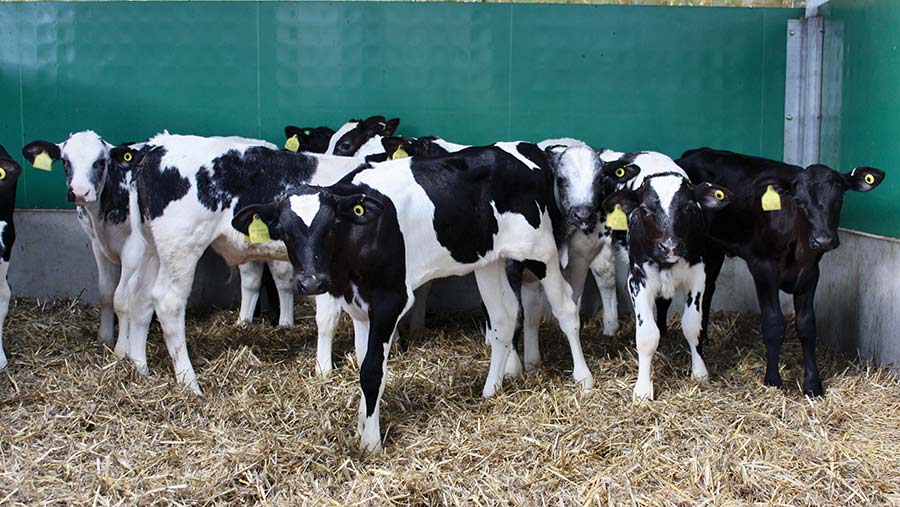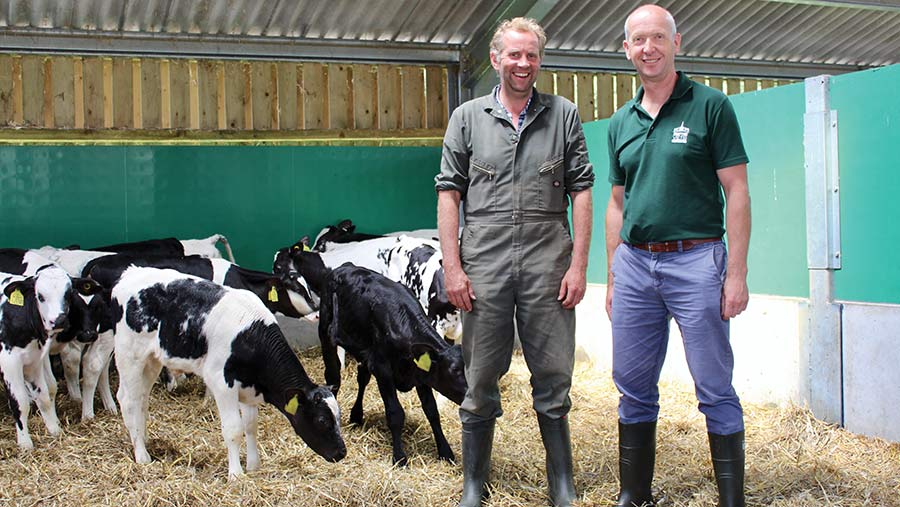How cow minerals unlocked calf health for Somerset farm
 © Aly Balsom
© Aly Balsom The Creeds are meticulous when it comes to calf rearing, so when animals suddenly started to get sick, it was a mystery as to why – until they discovered their dry cow minerals were out of date.
Further investigation also showed the mineral specification for the milkers and dry cows were mismatched with their forage mineral levels.
See also: How a calf unit has reduced antibiotics use by 60%
This meant they were not providing sufficient trace elements to support the herd.
As a result, last autumn, pneumonia incidence suddenly tripled and about three-quarters of animals required treatment for the worst scours ever seen on farm. Calf mortality subsequently increased from 2-2.5% to 10%.
“All of a sudden, things just went to pieces,” says Andy Creed, who farms with his father, Mark.
“We have a fortnightly vet visit and it got to the point where we’d do the cows relatively quickly and then spend an hour with the calves.”
At the same time, cows were “flying” and producing about 35 litres a head a day.
Farm facts
Knapp Farm, West Pennard, Somerset
- 320 Holsteins
- 243ha
- Cows yielding 10,500 litres a year at 4.3% butterfat and 3.5% protein
- Twice-a-day milking
- Rear own replacements and sell beef calves at market or via Buitelaar
- Dry cow diets – straw, maize silage, rapeseed, water and minerals
Calves were developing scours at about 36-48 hours old and were “dopey” and reluctant to get up. Andy says it was a challenge to get them to survive to 10 days old.
The farm team and Shepton Vets immediately instigated a thorough review. Total blood proteins showed calves were receiving adequate colostrum.
They were also on a good plane of nutrition and bovine viral diarrhoea and salmonella were not a problem.
Trace element status
They decided to investigate trace element status. Trace elements are only required in minute amounts compared with major minerals.
Important trace elements for cows include copper, iodine, selenium, and vitamins A, D and E.
Iodine plays a key role in metabolism, while selenium is important for immune function. Both were normal.
However, three out of four calves were deficient in vitamin E, which works with selenium for immune function. It was the associated immune suppression that was making calves sick.

Andy Creed and Paddy Gordon © Aly Balsom
“If we don’t have the inherent immunity in the animal, we’re going to struggle, whatever we do,” says vet Paddy Gordon of Shepton Vets.
He explains that calves receive trace elements across the placenta and via colostrum, so the mineral status of the dam impacts calf health.
And the calf’s demand for trace elements is particularly high in the last six weeks before calving.
Mineral review
Having identified trace elements as the issue, Andy looked at the product label for the minerals and discovered they were out of date by about six months.
This was because a large pallet load had been ordered and not used fast enough. The delay could have rendered them ineffective.
He also realised he had been using the same bespoke mineral for 15 years without changing it in response to forage analysis.
Calf management at Knapp Farm
- Purpose-built calf mono-pitch building
- Calves receive 10% of bodyweight in good-quality colostrum within two hours of birth and twice again at 12-hour intervals
- Fed 6 litres a day up to 8 litres a day through an automated milk feeding machine
- Six pens and four milk stations, allowing two pens to be rested after steam cleaning
- Low stocking rates of less than 20 calves per milk feeding point
- Positive pressure tube ventilation system
So, the farm’s nutritionist, Dave Hinkins of ForFarmers, carried out a whole-farm mineral assessment, testing individual forages and the milker and dry cow diets.
He found vitamin E levels were the main issue, with average available vitamin E 75% less than cow requirements across dry cows and milkers.
This could have been linked to the fact vitamin E degrades over time in conserved forages. Blood tests also showed cows were deficient in vitamin E.
Changes to diets
As a result, Dave increased vitamin E in the dry and milking diets. Other trace elements were also increased to a smaller extent (see “Mineral changes at Knapp Farm).
Mineral changes at Knapp Farm
Dry/transition cows
- Selenium raised from 4mg a cow a day to 7mg a cow a day
- Vitamin E raised from 400mg a cow a day to 1,600mg a cow a day
- Iodine taken to the maximum legal rate
Milking ration
- Selenium raised from 4mg a cow a day to 6mg a cow a day
- Vitamin E raised from 300mg a cow a day to 1,200mg a cow a day
- Iodine taken to legal maximum
- Vitamin A included at 110 IU*/kg of bodyweight
- Vitamin D included at 35 IU*/kg of bodyweight
Levels will be reviewed for this coming winter and checked again mid-winter and in the spring if forages are to be fed into the following summer.
*International unit used to measure some vitamins
Last year, forage mineral and trace element levels were particularly challenged because of the dry weather (see “Top tips for feeding minerals and trace elements”).
Dave says it takes time to build cow trace element status, so it is vital levels are correct in milking cows.
In the short term, calves were injected with vitamin E and selenium. It took about eight weeks for the effects of the new mineral to be seen in newborn calves.
Since the spring, calf health has returned to normal, with mortality now sitting at 2-3% and scours and pneumonia at 2%.
Andy says he was surprised vitamin E had such a devastating impact, having never considered it before.
It has encouraged him to regularly review trace element requirements and only buy what is needed.
“If you buy a part pallet of something, you get charged £50-£60 extra, but it pays dividends to buy in the amount you require,” he says.
Top tips for feeding minerals and trace elements
ForFarmers nutritionist Dave Hinkins and vet Paddy Gordon of Shepton Vets provide their key considerations when feeding minerals and trace elements.
- A bespoke mineral from 10 years ago may not be correct now. Forage mineral status will change from cut to cut and year to year. If yields or cow size have increased, cows will have a greater mineral requirement and levels will need to be addressed accordingly.
- Drought can distort forage mineral status. When roots go looking for moisture, they can also bring up antagonists from the soil, which can cause mineral lockup. An increase in forage molybdenum and iron levels, seen this year, can impact on copper.
- Oil-based vitamins such as A, D and E can degrade over time in conserved forages. This means that mineral levels need to be regularly checked throughout the feeding period.
- Review the mineral status of all types of stock routinely with a vet and carry out surveillance testing.
- Be particularly mindful of mineral status when feeding high-maize diets. Maize is naturally low in minerals and trace elements and there can also be a dilution factor at high inclusion rates.
- Only order what you need – buying a bigger pallet load of minerals may save money, but if you can’t use it by the use-by date, it will go past its shelf life and be ineffective.
- Check the label to see how long the mineral will last. Inclusion of additional products such as limestone or buffers will impact the shelf life.
- Adhere to guidelines on intakes – underfeeding could mean your minerals are ineffective; overfeeding will cost you money and could be dangerous.
- Regularly test forages for minerals – test when you start a new forage, when a forage is changed in the diet and at the end of the winter.
- Be aware the extensively managed (grazed) heifers will need supplementation. UK grazing is generally low in trace elements, which means supplementation is a must, particularly for growing heifers.
